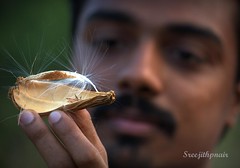Around six hours of boat journey in the pristine backwaters of north Kerala, for less than a Dollar.
Would you take it?
All you need is, a day to spare.
 I planned this journey many a times, but couldn’t make it, till yesterday.
I planned this journey many a times, but couldn’t make it, till yesterday.
I was free for the day and needed a story so badly. I called up the boat house for the schedule and came to know that, there is one starting at 10 am from “Kotti Jetty”, which is near Payyanur Railway station.
As usual, it was a race against time for me and a photo finish 🙂
Being a weekday, there was hardly anyone around and the boat crew (Five people) out numbered the passengers.

 As the boat entered the backwater and traveled due south, the Ezhimala hills provided a perfect backdrop.
As the boat entered the backwater and traveled due south, the Ezhimala hills provided a perfect backdrop.

Once it reached Thayyil Jetty, it reversed it’s direction and started the long journey northward following a zig zag pattern across the width of the backwater.
Landscape looked monotonous on both the banks for the untrained eyes. But there was a unique ecosystem so alive and thriving.
Most of the passengers used the boat to cross the backwater as there was only one bridge connecting the mainland to Valiyaparamba (narrow strip of land sandwiched between the sea and backwater).

 It was really interesting to just sit and watch people in action with a cool breeze on your face and thousand shades of green cooling your eyes and mind.
It was really interesting to just sit and watch people in action with a cool breeze on your face and thousand shades of green cooling your eyes and mind.


 We reached “Ayitti” jetty, by 11.30 am and there was a break for lunch. 12.30 pm, we resumed our journey and reached the northern most point of the trip(Padanna) by 1.15 pm.
We reached “Ayitti” jetty, by 11.30 am and there was a break for lunch. 12.30 pm, we resumed our journey and reached the northern most point of the trip(Padanna) by 1.15 pm.
After a small break we started the return trip and I tried to capture something I missed in the morning.



 For the final leg of the journey, I planned a little twist, and jumped off the boat on the other bank, near the beach. This is my favorite beach in the whole world, solely for the reason, that, you could find not even a single soul for kilometers in either direction.
For the final leg of the journey, I planned a little twist, and jumped off the boat on the other bank, near the beach. This is my favorite beach in the whole world, solely for the reason, that, you could find not even a single soul for kilometers in either direction.

 As the sun started to descend, I collected shells for my daughter and waited for the country boat to come.
As the sun started to descend, I collected shells for my daughter and waited for the country boat to come.
It was a long wait, but in the lap of nature, never a tiring one.
Suggestions on boat trip:
It’s always better to take the first three rows. Engine, being in the middle of the boat, causes quite some noise and vibration and it’s felt more in the rear seats.
Where to Have Food:
There is hardly any shop near the starting point (Kotti) and no option to buy anything on the way. There is a small hotel near the Ayitti boat office, which is 90 minutes away from the start. So, better take food and water along.
Where to Stay: You have some really good hotels to stay in Payyanur, the nearest town.
If you would like to finish the day, exploring the virgin beaches of valiyaparamba, and spend the night at one of the home stays, you have got some interesting options as well.
Best Time to Explore: For the boat journey it hardly matters, but, if you would like to have a great time at the beaches, it’s better to avoid the monsoon months (June to September). For mild temperatures and clear skies, you can plan for the winter months of December and January.
Boat Timing: Boat is scheduled to start from “Kotti” boat jetty at 6.30 AM, 10 AM and 4.15 AM.
If you are planning for a to and fro journey in a single boat, you can opt for the 10 AM one, which returns to the starting point by 4 PM.

































































